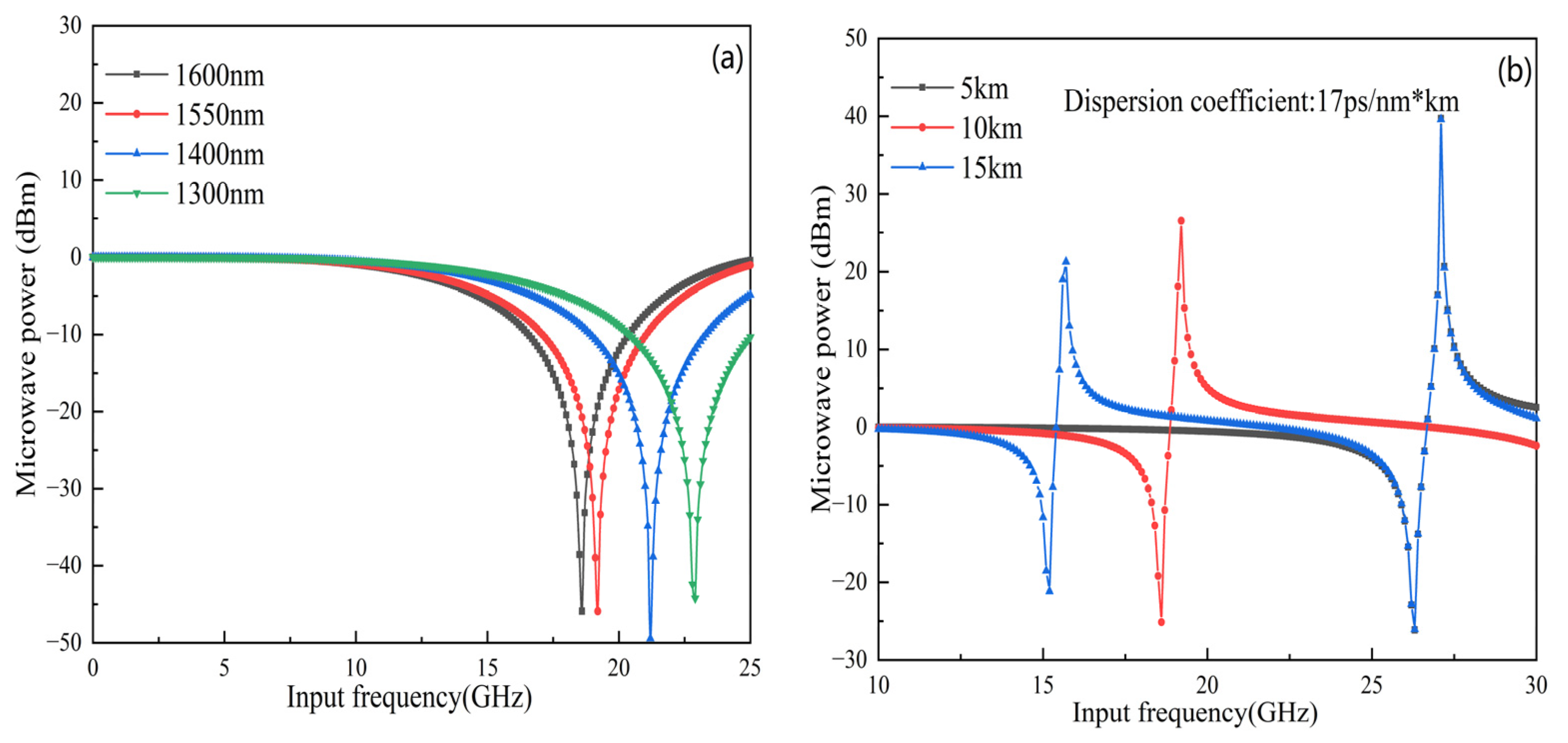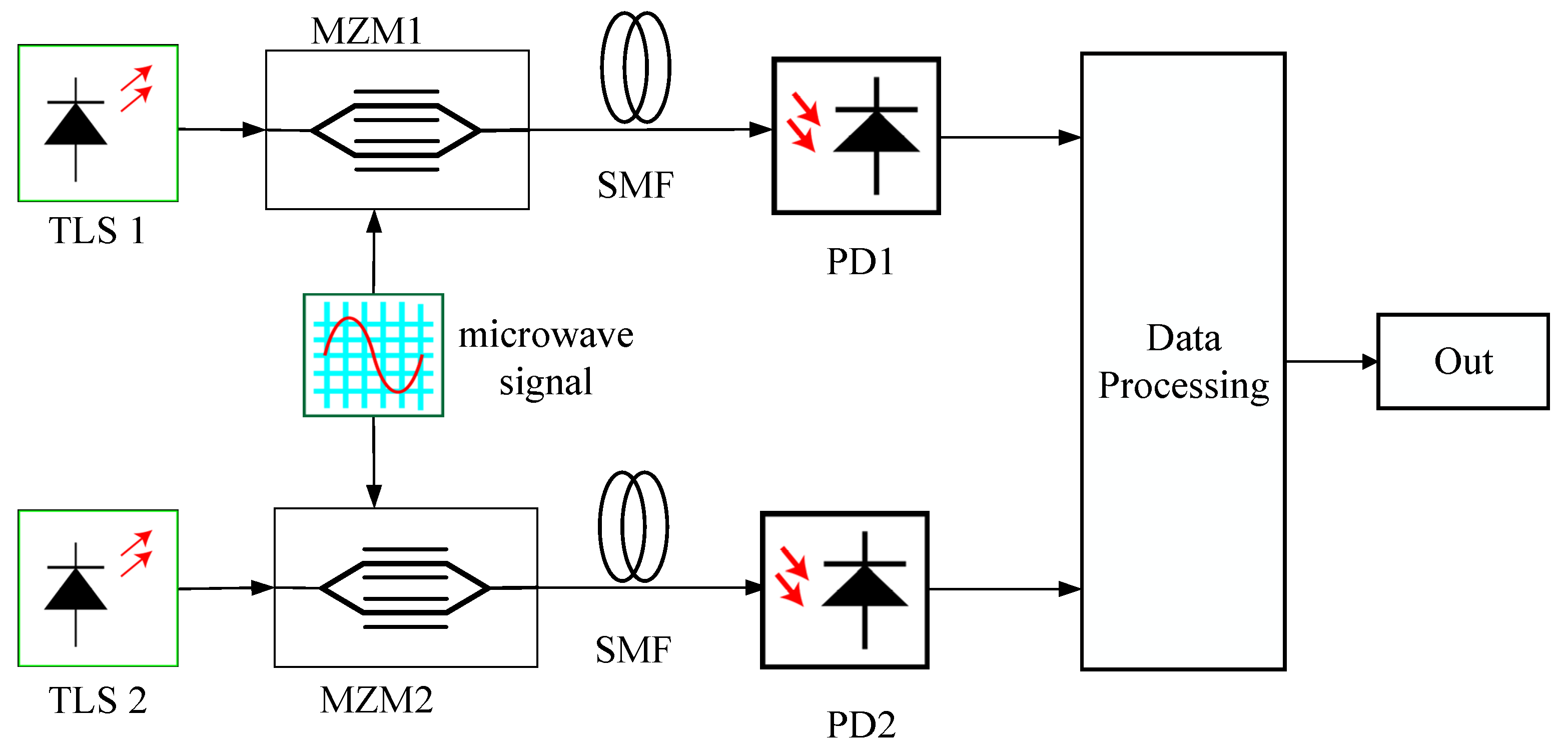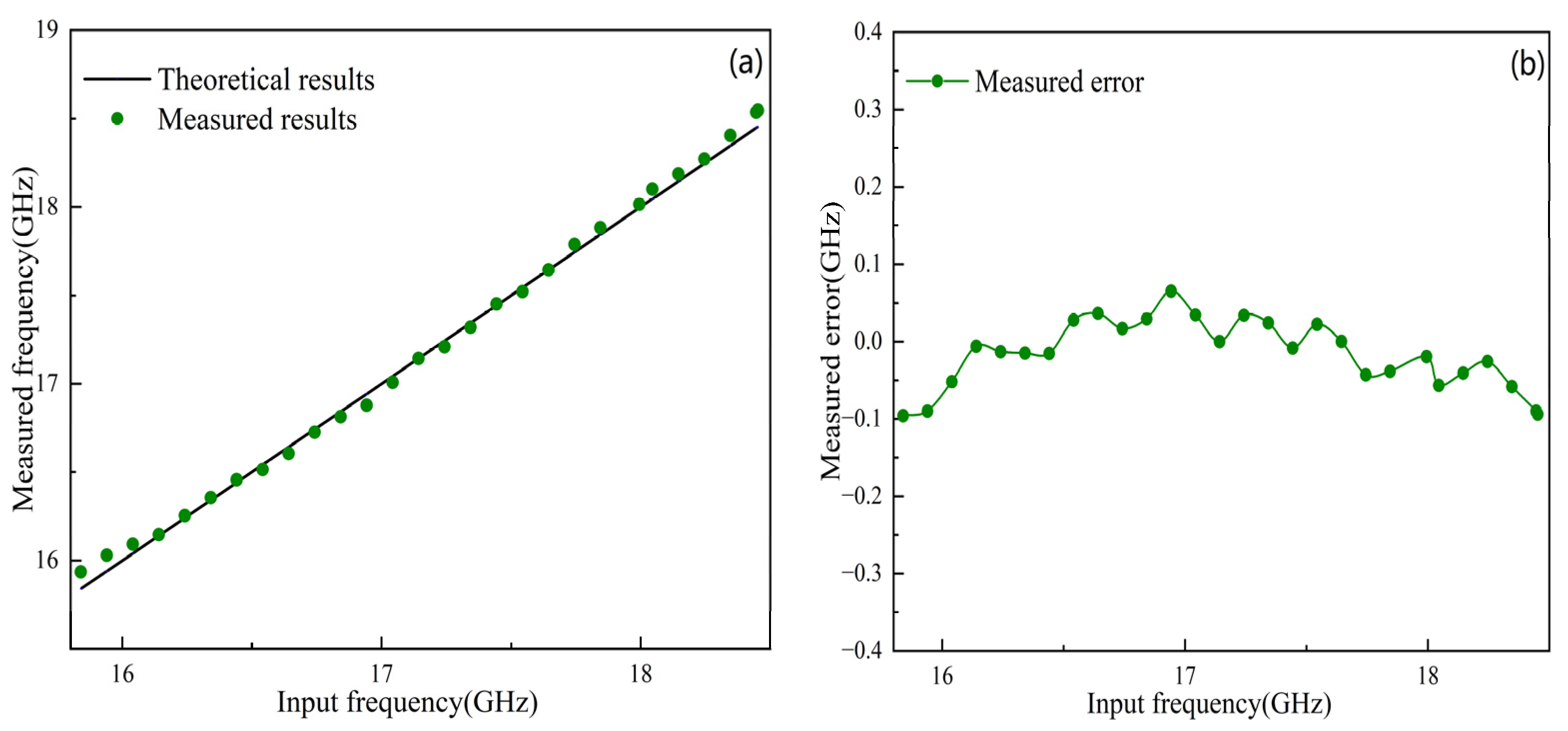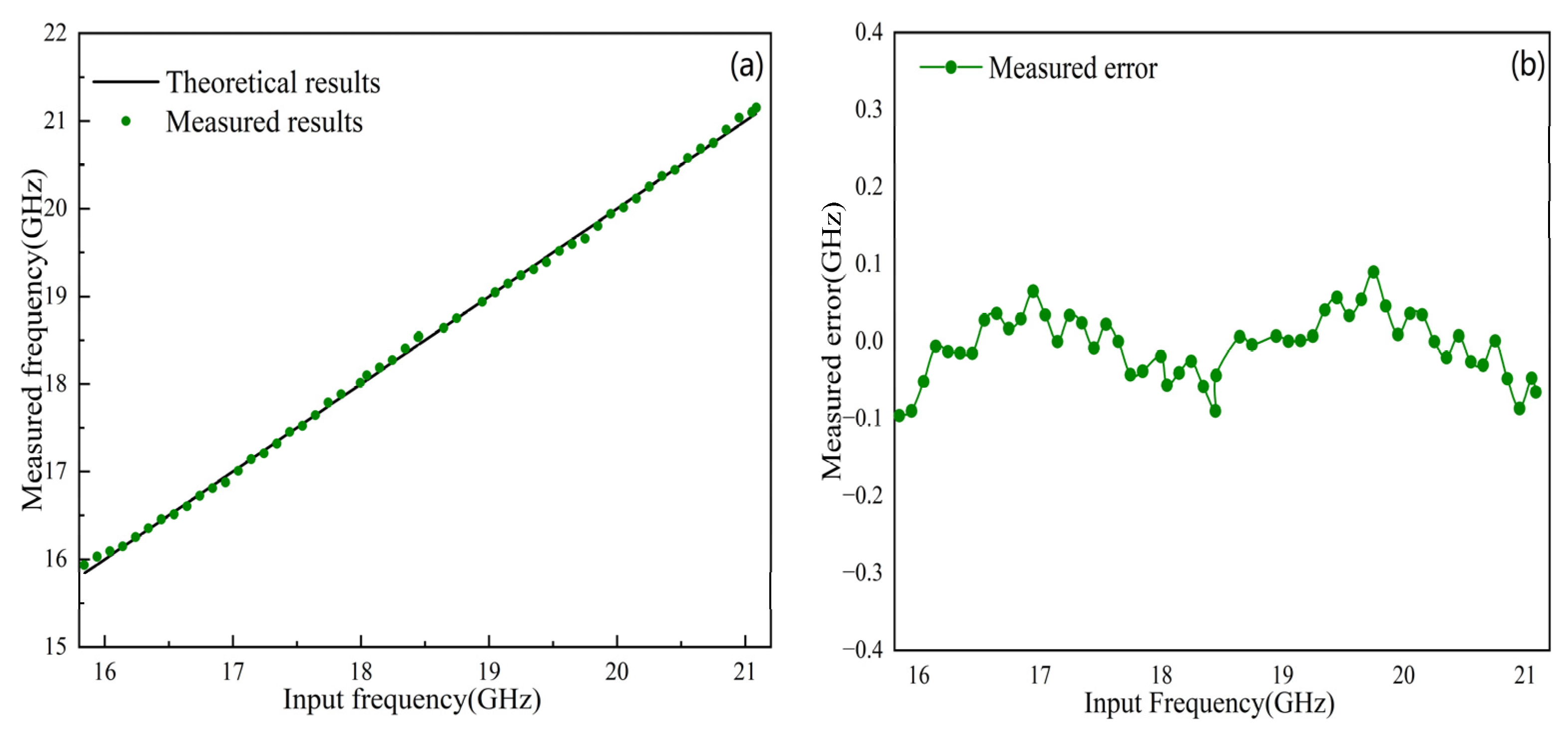Instantaneous Frequency Measurement with Reasonable Resolution and Simple Structure
Abstract
1. Introduction
2. Principle
3. Experimental Demonstration
4. Discussion
5. Conclusions
Author Contributions
Funding
Institutional Review Board Statement
Informed Consent Statement
Data Availability Statement
Acknowledgments
Conflicts of Interest
References
- Pan, S.; Fu, J.; Yao, J. Photonic approach to the simultaneous measurement of the frequency, amplitude, pulse width, and time of arrival of a microwave signal. Opt. Lett. 2012, 37, 7–9. [Google Scholar] [CrossRef] [PubMed][Green Version]
- Wiley, R.G. Electronic Intelligence: The Analysis of Radar Signals; Artech House: Boston, MA, USA, 1993. [Google Scholar]
- Spezio, A.E. Electronic warfare systems. IEEE Trans. Microw. Theory Tech. 2002, 50, 633–644. [Google Scholar] [CrossRef]
- Pan, S.; Yao, J. Photonics-Based Broadband Microwave Measurement. J. Light. Technol. 2016, 35, 3498–3513. [Google Scholar] [CrossRef]
- Pan, S.; Yao, J. Instantaneous photonic microwave frequency measurement with a maximized measurement range. In Proceedings of the 2009 International Topical Meeting on Microwave Photonics, Valencia, Spain, 14–16 October 2009. [Google Scholar]
- Winnall, S.T.; Lindsay, A.C.; Austin, M.W.; Canning, J.; Mitchell, A. A microwave channelizer and spectroscope based on an integrated optical Bragg-grating Fabry-Perot and integrated hybrid Fresnel lens system. IEEE Trans. Microw. Theory Tech. 2006, 54, 868–872. [Google Scholar] [CrossRef]
- Heaton, J.M.; Watson, C.D.; Jones, S.B.; Bourke, M.M.; Boyne, C.M.; Smith, G.W.; Wight, D.R. 16-channel (1- to 16-GHz) microwave spectrum analyzer device based on a phased array of GaAs/AlGaAs electro-optic waveguide delay lines. In Proceedings of the International Society for Optical Engineering, San Jose, CA, USA, 28–30 January 1998; pp. 245–251. [Google Scholar]
- Wang, L.X.; Zhu, N.H.; Li, W.; Wang, H.; Zheng, J.Y.; Liu, J.G. Polarization division multiplexed photonic radio-frequency channelizer using an optical comb. Opt. Commun. 2013, 286, 282–287. [Google Scholar] [CrossRef]
- Wang, W.; Davis, R.L.; Jung, T.J.; Lodenkamper, R.; Lembo, L.J.; Brock, J.C.; Wu, M.C. Characterization of a coherent optical RF channelizer based on a diffraction grating. IEEE Trans. Microw. Theory Tech. 2001, 49, 1996–2001. [Google Scholar] [CrossRef]
- Nguyen, L.V.T. Microwave photonic technique for frequency measurement of simultaneous signals. IEEE Photonics Technol. Lett. 2009, 21, 642–644. [Google Scholar] [CrossRef]
- Nguyen, T.A.; Chan, E.H.W.; Minasian, R.A. Instantaneous high-resolution multiple-frequency measurement system based on frequency-to-time mapping technique. Opt. Lett. 2014, 39, 2419–2422. [Google Scholar] [CrossRef]
- Zhang, B.; Zhu, D.; Lei, Z.; Xu, Z.; Zhou, T.; Zhong, X.; Chen, Z.; Pan, S. Impact of dispersion effects on temporal-convolution-based real-time Fourier transformation systems. J. Light. Technol. 2020, 38, 4664–4676. [Google Scholar] [CrossRef]
- Salem, R.; Foster, M.A.; Gaeta, A.L. Application of space–time duality to ultrahigh-speed optical signal processing. Adv. Opt. Photonics 2013, 5, 274–317. [Google Scholar] [CrossRef]
- Wang, C. Dispersive Fourier transformation for versatile microwave photonics applications. Photonics. Multidiscip. Digit. Publ. Inst. 2014, 1, 586–612. [Google Scholar] [CrossRef]
- De Chatellus, H.G.; Cortés, L.R.; Azaña, J. Optical real-time Fourier transformation with kilohertz resolutions. Optica 2016, 3, 1–8. [Google Scholar] [CrossRef]
- Shi, J.; Zhang, F.; Ben, D.; Pan, S. Simultaneous radar detection and frequency measurement by broadband microwave photonic processing. J. Light. Technol. 2020, 38, 2171–2179. [Google Scholar] [CrossRef]
- Hao, T.; Tang, J.; Shi, N.; Li, W.; Zhu, N.; Li, M. Multiple-frequency measurement based on a Fourier domain mode-locked optoelectronic oscillator operating around oscillation threshold. Opt. Lett. 2019, 44, 3062–3065. [Google Scholar] [CrossRef]
- Nguyen, L.V.T.; Hunter, D.B. A photonic technique for microwave frequency measurement. IEEE Photonics Technol. Lett. 2006, 18, 1188–1190. [Google Scholar] [CrossRef]
- Li, W.; Zhu, N.H.; Wang, L.X. Reconfigurable instantaneous frequency measurement system based on dual-parallel Mach–Zehnder modulator. IEEE Photonics J. 2012, 4, 427–436. [Google Scholar] [CrossRef]
- Attygalle, M.; Hunter, D.B. Improved photonic technique for broadband radio-frequency measurement. IEEE Photonics Technol. Lett. 2008, 21, 206–208. [Google Scholar] [CrossRef]
- Zou, X.; Yao, J. An optical approach to microwave frequency measurement with adjustable measurement range and resolution. IEEE Photonics Technol. Lett. 2008, 20, 1989–1991. [Google Scholar]
- Li, J.; Fu, S.; Xu, K.; Zhou, J.Q.; Shum, P.; Wu, J.; Lin, J. Photonic-assisted microwave frequency measurement with higher resolution and tunable range. Opt. Lett. 2009, 34, 743–745. [Google Scholar] [CrossRef]
- Li, W.; Zhu, N.H.; Wang, L.X. Brillouin-assisted microwave frequency measurement with adjustable measurement range and resolution. Opt. Lett. 2012, 37, 166–168. [Google Scholar] [CrossRef]
- Zou, X.; Chi, H.; Yao, J. Microwave frequency measurement based on optical power monitoring using a complementary optical filter pair. IEEE Trans. Microw. Theory Tech. 2009, 57, 505–511. [Google Scholar]
- Chi, H.; Zou, X.; Yao, J. An approach to the measurement of microwave frequency based on optical power monitoring. IEEE Photonics Technol. Lett. 2008, 20, 1249–1251. [Google Scholar] [CrossRef]
- Zou, X.; Pan, S.; Yao, J. Instantaneous microwave frequency measurement with improved measurement range and resolution based on simultaneous phase modulation and intensity modulation. J. Light. Technol. 2009, 27, 5314–5320. [Google Scholar]
- Pan, S.; Yao, J. Instantaneous microwave frequency measurement using a photonic microwave filter pair. IEEE Photonics Technol. Lett. 2010, 22, 1437–1439. [Google Scholar] [CrossRef]
- Yang, C.; Wang, L.; Liu, J. Photonic-assisted instantaneous frequency measurement system based on a scalable structure. IEEE Photonics J. 2019, 11, 1–11. [Google Scholar] [CrossRef]
- Zhou, J.; Fu, S.; Aditya, S.; Shum, P.P.; Lin, C. Instantaneous microwave frequency measurement using photonic technique. IEEE Photonics Technol. Lett. 2009, 21, 1069–1071. [Google Scholar] [CrossRef]
- Bui, L.A. Recent advances in microwave photonics instantaneous frequency measurements. Prog. Quantum Electron. 2020, 69, 100237. [Google Scholar] [CrossRef]







Publisher’s Note: MDPI stays neutral with regard to jurisdictional claims in published maps and institutional affiliations. |
© 2022 by the authors. Licensee MDPI, Basel, Switzerland. This article is an open access article distributed under the terms and conditions of the Creative Commons Attribution (CC BY) license (https://creativecommons.org/licenses/by/4.0/).
Share and Cite
Ding, Q.-A.; Li, J.; Liu, H.; Cheng, X.; Liang, A.; Du, L.; Zheng, L.; Dai, Z.; Yang, Q.; Li, J. Instantaneous Frequency Measurement with Reasonable Resolution and Simple Structure. Photonics 2022, 9, 685. https://doi.org/10.3390/photonics9100685
Ding Q-A, Li J, Liu H, Cheng X, Liang A, Du L, Zheng L, Dai Z, Yang Q, Li J. Instantaneous Frequency Measurement with Reasonable Resolution and Simple Structure. Photonics. 2022; 9(10):685. https://doi.org/10.3390/photonics9100685
Chicago/Turabian StyleDing, Qing-An, Junkai Li, Huixin Liu, Xudong Cheng, Anhui Liang, Liuge Du, Li Zheng, Zhenfei Dai, Qunying Yang, and Jun Li. 2022. "Instantaneous Frequency Measurement with Reasonable Resolution and Simple Structure" Photonics 9, no. 10: 685. https://doi.org/10.3390/photonics9100685
APA StyleDing, Q.-A., Li, J., Liu, H., Cheng, X., Liang, A., Du, L., Zheng, L., Dai, Z., Yang, Q., & Li, J. (2022). Instantaneous Frequency Measurement with Reasonable Resolution and Simple Structure. Photonics, 9(10), 685. https://doi.org/10.3390/photonics9100685




